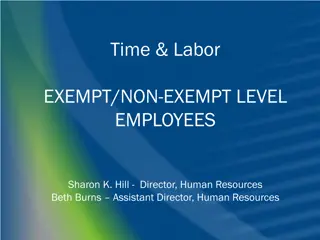Understanding Long-Term Lay-Off and Employee Rights
Long-term lay-offs allow employees to terminate their employment without notice, with compensation due after 200 days. Employers must pay compensation immediately upon resignation. Exceptions apply to partial lay-offs and refusal of short-term work. Continuous work during a lay-off, including annual holiday, is considered part of the 200-day rule.
Download Presentation

Please find below an Image/Link to download the presentation.
The content on the website is provided AS IS for your information and personal use only. It may not be sold, licensed, or shared on other websites without obtaining consent from the author. Download presentation by click this link. If you encounter any issues during the download, it is possible that the publisher has removed the file from their server.
E N D
Presentation Transcript
Lay-off employees right to terminate their employment with immediate effect Under the Employment Contracts Act employees may terminate their employment contract during lay-off without a period of notice, regardless of the duration of the lay-off. This right also applies to fixed-term employees. This right does not apply during the 7 days before the end of the lay-off if the employee knows when the lay-off will end.
If a lay-off has lasted at least 200 days If an employee terminates his/her employment contract when a lay-off has lasted at least 200 consecutive calendar days, he/she is entitled to compensation This is equivalent to the wages paid in accordance with the termination notice period binding on the employer (as if the employer had dismissed the employee) This rule is designed to prevent employers getting round the employee s protection against dismissal and right to wages for the termination notice period by letting the employment relationship and lay-off drag on The 200-day rule applies to lay-offs of both indefinite and fixed duration. 3
Compensation is due immediately The employer must pay the employee compensation immediately on being informed of the employee s resignation and demand for compensation. The employee s employment relationship ends immediately and thus the employee is entitled to compensation without any obligation to perform work. Holiday compensation is also paid for the notice period binding on the employer (KKO 2000:91). If for legal or contractual reasons the employer has been obliged to observe a 14-day notice period before the lay-off starts, the employer may deduct 14 days from the wages for the termination notice period (in practice doesn t affect PAM sectors can t deduct 14 days)
No right to compensation The 200-day rule does not apply to partial lay-offs. (KKO 2015:43) A lay-off that is implemented by reducing working hours is not a continuous lay-off within the meaning of the Employment Contracts Act. A laid-off employee is not entitled to compensation even if a partial lay-off has lasted 200 days Situations in which the time at work during a lay-off represents only a very small part of regular working hours during the entire lay-off are an exception to this. Laid-off employees lose their right to compensation if they refuse short-term work offered before the lay-off has lasted 200 days. 5
Getting round the rule Annual holiday between lay-off periods does not mean a break in continuity, and annual holiday is considered part of the 200 days (KKO 1999:45) Short-term work offered to get round the rule does not affect the continuity of a lay-off. With consecutive fixed-term lay-offs, it has to be assessed why these have been used. If they have been used to get round the law and their total duration is over 200 days, the employee is entitled to compensation for the termination notice period binding on the employer. 6
Getting round the rule The employer is required to offer work as an alternative to lay- off. If there is no work corresponding to the employment contract, the employer must offer other suitable work as far as possible. This must be taken into account in assessing whether short-term work has been offered just so that the employee would not be entitled to wage compensation. The genuineness of a work offer is assessed based on the company s financial situation and operational capabilities. It is an overall assessment taking into account the length of the working period, the nature of the work and the circumstances in which the employer has made the lay-off decisions. Must also assess if the work done by those called in was genuine, necessary for the company and work that one of the employees would have had to do in any case. 7
Right to pay security also applies to compensation for long-term lay-off If an employer is insolvent, pay security guarantees unpaid wages and other claims based on the employment relationship The maximum amount of claims that can be paid as pay security is 15,200 euros Employee must apply for pay security within three months of the claim, e.g. wages, falling due. The authority responsible for pay security is the Centre for Economic Development, Transport and the Environment (ELY Centre). Pay security applications should be made electronically on the ELY Centre website (log in with online banking codes) For a video on how to complete applications: www.pam.fi (https://www.youtube.com/watch?v=ozcVx5qoE-4&feature=youtu.be)
But.. If a lay-off has lasted a long time, the likelihood of an employer becoming insolvent also increases The processing time for pay security applications is on average at least 6 months. Also, where there is a rightto compensation (equivalent to wages for the termination notice period binding on the employer), under the Unemployment Security Act it is divided into periods: for example, if the termination notice period binding on the employer is 6 months, entitlement to unemployment allowance only begins after this period (regardless of whether compensation has been paid or whether a pay security decision must be awaited) Also, in the case of damages-type payments, these are not taken into account in employment earnings for pension purposes. 9























